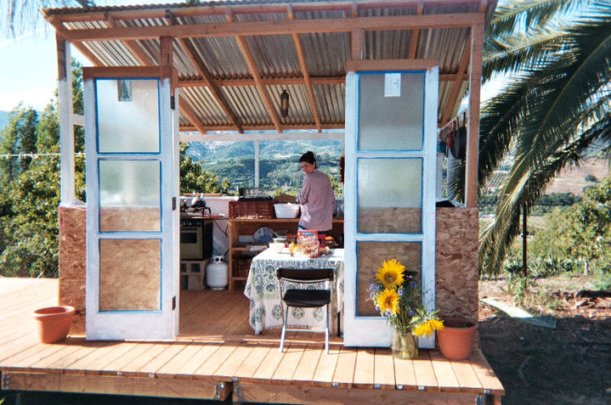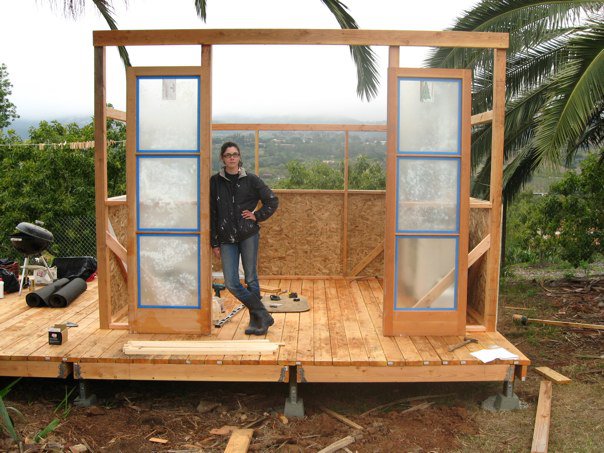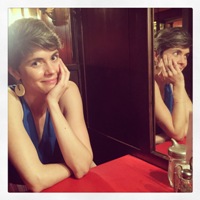
The vision was grand.
In the winter of 2009-2010, Matthew and I had just reunited after a college breakup three years earlier, and we wanted to build a life together.
I was living in New Mexico, working at a job that made me feel like I’d prematurely descended into middle age. Matthew had just found his way out to California after walking off a food service job in Yellowstone National Park because he refused to wear the dorky hat that was part of the uniform.
Neither of us wanted people telling us what to do.
We hatched a plan for me to join him in Carpinteria, where he was working on an avocado ranch. Matthew had recently become obsessed with yurts, the traditional dwelling of Mongolian nomads and upper-middle-class hippies, and we envisioned building a large one on the ranch and living in it for a few years.
He joined me for a few months in New Mexico that winter, and we spent hours planning our future life. We relearned trigonometry and drew up plans. We even built a scale model of the yurt out of coffee stirrers and thumbtacks, fretting over it at the dining room table. We imagined filling our future home with Turkish rugs, chandeliers, and a woodstove. Finally, in April, it was time. I quit my job, we packed up our things, and drove across the desert. The first night, we lay in a tent under a palm tree and listened to owls and coyotes echoing across the canyon. We were really doing it.
Almost immediately, I discovered that my Northern European skin wasn’t made for near-constant sun exposure, and I became covered in blisters. The palm tree above our tent turned out to be a rat hotel whose residents chewed holes through our belongings. We worked long hours on the farm and sold lemons and avocados at area farmers’ markets.
The markets were a fantasy. Most of the produce was grown by Mexican immigrants, but most of the vendors looked like me. Women strolled through the markets after their yoga classes to buy fruit for their smoothies, likely imagining that I had ascended a rustic ladder at sunrise and plucked a few lemons just for them. Trustafarians loitered by the stalls saying things like, “No worries,” and “It’s all good.”
This infuriated me because I was actually very worried, things weren’t all good, and didn’t they realize that these markets were an illusion? I had quit my salaried job, was 3,000 miles away from my family in Connecticut, lived in a tent with rats, and was covered in sores because I was literally allergic to my life. I had worries.

But life started to have a rhythm, and I even developed what, in the right light, might be called a tan. Matthew was made for the sun, and had turned an enviable shade of bronze. He even got natural golden highlights in his hair, slowly transforming into Tom Hanks at the end of Castaway.
We’d decided that building a yurt was less of a priority than having places to cook and bathe, so after completing the large platform that the yurt would sit on, we built a kitchen structure, complete with propane stove and cold-water sink. We found a pair of used eight-foot-tall glass doors, likely from a mansion in Montecito that was being renovated, and made a palatial entrance below the corrugated tin roof. I hung a pepper ristra from New Mexico on a beam, along with our collection of skillets. We lugged a cast-iron tub to the property and connected it to a solar-powered hot water heater of Matthew’s design that even kind of worked.
We continued toiling that way for the rest of the summer, spending every hour of daylight when we weren’t working and every dollar we made building our home.
It was a difficult time. My dad’s sister died the first month we were there, and I deeply missed my family. We didn’t have a social life, because we were working all the time and didn’t have any money. The couple who employed us and whose land we were living on sent us mixed messages about whether they even wanted us there, and we were losing our battle with the rats. They haunted my dreams.
By the time we decided to leave that September, we had just finished the framing for the yurt. We set it up for the first time as the sun was setting, with our dilapidated tent sitting inside of it. It was beautiful.
Then the next day we took it down and left forever.
We crammed what we had into and on top of our two-door Honda Civic and started driving east, passing western wildfires and chugging slowly over the Rockies, barely breaking 25 miles an hour on the inclines because of our heavy load. I remember the relief I felt the night after we’d driven across the Great Plains, opening the car door to the pulsing sound of late-summer insect life that doesn’t exist in the desert. The humidity of the east coast felt like a warm embrace.
After we left California, there was no way to know what had become of the home we had made there. Since we’d parted from the landowners on somewhat awkward terms, we didn’t even try to stay in touch. As the years passed, I imagined our little compound returning to a state of nature, bleaching to bone in the sun.
The story of that summer became the way I made sense of our relationship, one that ended three years after we’d first pitched our tent under the palm tree. We had built something beautiful with great difficulty. It had caused me pain but also filled me with an aliveness I have not felt since. When the time came to leave it behind, we knew it, and did what we needed to do. I haven’t seen Matthew once since we parted ways in 2013, and we don’t speak. Time passes, and I make sense of it on my own.
But sometimes your memories become entangled with others’ dreams. Recently I was getting a beer with a friend, and she pulled up a picture she’d stumbled upon on Instagram.
My heart stopped. Two women were standing in the doorway of our kitchen structure in the shadow of the palm tree, dwarfed by the majestic eight-foot glass doors.
“About to cook up a storm in Mary’s outdoor kitchen,” the caption read. More pictures on the feed showed closeups. “Many dreamy afternoons are spent cooking in this outdoor kitchen,” gushed one. “This is freaking magical,” said one commenter, following with five heart emojis. “My dream,” said another. Nearly a thousand people had liked the photo.
My thumbs tapping furiously, I discovered that “Mary’s outdoor kitchen” had been featured in the most recent issue of a food magazine, in a piece that described a book project of Mary’s where the kitchen would also be featured.
The photo spread showed friends gathering for dinner in slanting sunlight around a table that Matthew had built for us, a red chair we’d left behind artfully positioned nearby, and our kitchen structure forming the scenic backdrop.
I was dumbfounded.
Instagram was launched less than two weeks after Matthew and I had landed in Durham, humbled and ready to try another kind of life. In the years since, the app has turned into a bustling forum for lifestyle fetishists. The home we had struggled to build together had become another thing for internet strangers to gush over as they ate at their desks during their lunch breaks and imagined another life.
Was I angry? What was I feeling? I wished I could call Matthew to process it with him, but our breakup, after we had spent the better part of a painful decade hurting and loving each other, wasn’t the kind that naturally led to friendship.
I sent Mary a direct message on Instagram.
“I’m so curious what it’s like now, and how you ended up there,” I wrote. “I would love to connect.”
I never got a response. Part of me was reflexively defensive, like this person had quietly slipped into the old life I had left behind and made it Instagram-ready, implying by omission that she had conceived of the whole thing and built it on bare ground. But how could she know who I am? What did I expect? Mary actually seemed like a nice person trying to live a beautiful and sustainable life as she worked on a cool-sounding book project, posting on social media all the while, like we all do. And don’t most of us live in someone else’s home, when you think about it?
I’m 30 now, so I entered adulthood at the dawn of the social-media revolution. Sometimes I imagine that, before the internet, the narratives people told themselves and others about the past were simpler. You fell in love, you parted ways, and you watched that person recede into the distance of your memory. You receded into the distance of his memory too, and if your diverging perspectives offered very different views of your time together, so what? You could keep your story, and he could keep his. The internet wasn’t going to intrude with pictures of his new girlfriend and strangers living in the house you built together.
I had my own story about that summer, and the end of that story was that what we had built had melted into the landscape after we couldn’t make it work. It had dissolved as our relationship dissolved because that’s how I needed the story to end. It wasn’t meant to end up on someone else’s lifestyle blog.
But Instagram itself is the ultimate venue for cleaned-up narratives. Things that muddy the view are pushed out of the frame (I wonder if Mary has to use that nasty Port-A-Potty like we did, and if the humming silicone-implant factory is still on the other side of the chain-link fence from the lemon trees).
We have always tried to make our stories more simple, more beautiful, more in our favor, and Instagram has just made that easier to do. We crop, we forget, we lie, we omit, and what’s left is an alluring story about the life we wish we had.
Author: Margaret Hennessey
Images: Courtesy of Alicia Elkins, Matthew Kai-Uve
Editor: Catherine Monkman











Read 0 comments and reply